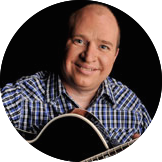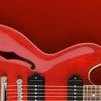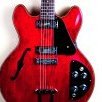
kenneth
Members-
Posts
18 -
Joined
-
Last visited
Reputation
5 NeutralAbout kenneth
- Birthday 02/03/1988
Personal Information
-
Location
Belgium
Recent Profile Visitors
The recent visitors block is disabled and is not being shown to other users.
-
Session 11 - Pentatonic Scales
kenneth replied to NeilES335's topic in Gibson's Learn & Master Guitar
It's been the better part of a year and I am still practicing session 11. Not sure if that is normal but there is just so much to take in that I feel as if this session really opens up the entire neck/fretboard. It really forces you to learn where each note is at, which in and of itself is extremely valuable, and requires a thorough understanding of the scales combined with each root note to start playing something that sounds like a guitar solo. The trick really seems to be starting off and ending at the root notes. Going over the entire fretboard through the scales implementing this idea has really been changing things for me, as in I'm finally beginning to understand the instrument and how it needs to be played. I also understand now why Steve has not forced anything written on us to practice, since that would take away the entire purpose of learning what really needs to be learned here. I am sure others will want to skip this session or round it up faster somehow but I am beginning to understand why this one is an extremely important one that can not be taken lightly, it really is the key to understanding the guitar. -
Session 11 - Pentatonic Scales
kenneth replied to NeilES335's topic in Gibson's Learn & Master Guitar
PS. After having watched the BB king video and the lesson from Steve, I am hoping this is not the level us session 11 guys need to be yet, because of all of the added half step notes they are playing, but I get what you are saying, being that these are great for smaller licks and eventually will blend right into what we are about to learn. Guessing that this is very useful in getting to learn where the notes are as Steve says in the session 11 video lessons. The one thing that was really confusing was the link between the major and minor roots, i.e. the first position. The two-in-one pattern really had me confused since it is not the major scale first position, but the minor scale first position as it goes up 3 frets, or one and a half step. This is however the last position in the major scale if you link all of them together, so technically correct as they are relatives, but confusing at the same time. It didn't make sense that a major root was played second, but I now understand that the A minor pattern being played was just the first position in the minor scale, not the first position in the C major scale (but the last). This for some reason has been more confusing than the patterns themselves. -
Session 11 - Pentatonic Scales
kenneth replied to NeilES335's topic in Gibson's Learn & Master Guitar
Awesome advice, thanks all! Still working on this session, actually finally arrived at the point of understanding that a minor pentatonic scale skips half a step more from the root on the 6th string (up 3 frets), whereas a major goes up only a whole step from the root note. So it has taken me a while to figure that one out, and have struggled with where to start the scales, but the insight has finally opened this session up so it's been well worth sticking it out. @Eracer_Team-DougH Particularly like blues, and like the vintage bluegrass/country style of music. Love the darker, muted blues that have the guitar sounding like an old steam train. Choo-choo! -
Session 11 - Pentatonic Scales
kenneth replied to NeilES335's topic in Gibson's Learn & Master Guitar
Anyone else having a hard time shaping some decent solos with this? Getting the notes down is one thing, actually composing a solo that sounds good too other than being harmonic is a different matter entirely. Wish there were examples of pentatonic scale solos in the book. -
Session 10 - Fingerstyle Guitar
kenneth replied to NeilES335's topic in Gibson's Learn & Master Guitar
If anyone else is struggling with the change to F major bar chord, grabbing the F note first really seems to help in shaping the chord efficiently. Might even be the proper technique. Wish the course would spend more time on these practical issues but it also forces you to practice more and correct your own mistakes, which ultimately can't be a bad thing -
Session 10 - Fingerstyle Guitar
kenneth replied to NeilES335's topic in Gibson's Learn & Master Guitar
Bumping this thread with a couple of questions This session has really forced me into improving the bar chord technique, which helps since I'm not always muting the strings anymore (still practicing on acoustic), ironically though, I'm finding it quite challenging now to smoothly change between a regular chord and the F major bar chord. It takes me quite some time to get the fingers positioned correctly and get clean sounding strings. Any tips on how to improve/speed up the chord transition? Apart from that, I am also wondering how to play the 5 note C shape in the Giuliani exercise, along with the G7, do you have to add your pinky to play the D note? Thanks! -
Session 8 - Barre Chords on the 5th String
kenneth replied to NeilES335's topic in Gibson's Learn & Master Guitar
Thanks Mike, explains a lot! I figured the minor scale didn't use the w w h w w w h building pattern, so your answer clears up a lot! I'm not sure if I missed this somewhere or if this is irrelevant in this part of the course, in any case it had me confused since I thought the minor scale used the same steps. You've also taught me that the two notes at the beginning and the end of the scale are each other's octaves, hadn't figured that one out yet. Thanks again! -
Session 8 - Barre Chords on the 5th String
kenneth replied to NeilES335's topic in Gibson's Learn & Master Guitar
Hey, In session 8 there is a section dedicated to relative major and minor scales, it says you should build a relative minor 8 note scale starting from the note that is either 6 steps up or 2 steps down from the beginning/end of the major scale. unfortunately it doesn't say HOW to build a relative minor scale. Is this the same as a major scale, apart from some flats? Anyone care to elaborate or does this question recur later in the course? Thanks in any case. -
Session 8 - Barre Chords on the 5th String
kenneth replied to NeilES335's topic in Gibson's Learn & Master Guitar
That moment when after a couple of days of practicing Jamaica Farewell and wondering why your B string sounds out of tune, you realize the B note in the song is flat... -
Session 7 - Barre Chords on the 6th String
kenneth replied to NeilES335's topic in Gibson's Learn & Master Guitar
Thanks... Turns out the joints in my fingers where I would naturally place the first finger land exactly on top of the B and D strings, creating a type of gap for these strings in particular. I'm getting there on the Fmaj barre chord repositioning my first finger but the F7 barre chord is a pain. Found out the D string will also sounds muted attempting this chord. Slightly rolling the finger towards the headstock helps, but it's probably going to take finger placement consistency in my case. However, when I just attempt the barre using only one finger, most if not all of the strings will ring out, I guess I'm still losing a bit of strenght in the first finger adding the other notes. I'm working on it... -
Session 7 - Barre Chords on the 6th String
kenneth replied to NeilES335's topic in Gibson's Learn & Master Guitar
Hi, Was wondering if anyone else has had trouble with the B-string playing 6th string barre chords? For some reason I'm having trouble getting that string to ring out, even higher up the neck where the tension isn't that great. This is less of a problem playing just 5 or 4 strings. It gets even worse with the added notes. It seems to have more to do with finger placement than it does with strength, I'm wondering if there's an easy fix to this problem besides getting the guitar reset. I'm playing an acoustic steel string for what it's worth. Thanks -
@Eracer_Team-DougH Thanks again for the help. I've been working on the alternate picking but am still somewhat struggling with it. I know some next notes require an alternate pick, and it seems that if I use the same picking pattern on those, that's when I will hit the wrong string most of the time. So I get why I should be practicing this technique, I am still wondering however why the course hasn't yet brought this forward, except for the alternate picking on the same string eighth notes. Don't get me wrong I absolutely love the course but am just wondering if this is something that will be taught in other sessions, or am I expected to figure this out by myself over the length of the course itself? I am really hoping more time will be spent learning right hand picking techniques. Is it okay if for now if I just use an alternate pick at times when I hit the wrong strings, to correct it, or should I really be doing it every time the direction of the next note(s) and hand movement changes? I am currently at Minuet in G, it more or less sounds okay except for some wrong string errors sometimes, I really do hear a difference in tonal quality on the upstroke compared to the downstroke, the downstrokes are definitely richer when it comes to tone. Should I be studying the dvd workshops? I have figured out how to play the songs at the end of each session on my own, I am hoping I am not missing anything important when it comes to technique in doing so. Thanks
-
@Eracer_Team-DougH Thanks for the elaboration! I get it now... Direction dictates picking pattern. To summarize; My pinky finger should be resting on the pickguard when playing strings 1 to 4 (EBGD), and on the high (thin) E-string to be able to reach strings 5 and 6 (AE). In doing so the palm of my hand isn't resting on the guitar's body but is rather floating over the strings. I think I get why eighth notes require alternate picking now. Thanks!!
-
Oh, okay, I was getting pretty fast at singling out individual notes and strings with the all-upstrokes picking pattern but have followed the advise from @NeilES335 and have now adopted a downwards picking pattern for the exercises, to turn this into a new and hopefully better habit over time. The key seems to be hidden in finding a comfortable spot for the right hand to rest. I wish Steve would have elaborated a bit more on this from the get go since the different opinions are having me somewhat confused right now. From what I understand, alternate picking isn't only to be exercised in the case of eighth notes? The lesson book mentions bracing the pinky on the pickguard, however, this means the rest of the hand is somewhat floating over the strings on downstrokes and this isn't exactly comfortable (to me at least). I've found a somewhat comfortable right hand position to pick with downstrokes, I will now brace my right hand's side over the bridge pins, but in both instances I will often (mistakenly) hit the D-string when I should be playing a C note on the A-string (e.g.), which, needless to say, is sometimes tempting me to return to the all-upwards picking pattern, in which I will brace my right hand in the upper bridge area, rolling it back and forth to be able to reach all of them notes. So it kind of makes sense to have at least 2 different right hand 'anchor points' to be able to reach all of the strings using downstrokes too, but this involves different movements requiring different techniques which I haven't figured out yet. I absolutely refuse to look at the strings since I want to develop an extra sense for where they are at with muscle memory. I could probably manage to turn the all-downwards picking pattern into a new habit with more time and practice, and an extra anchor point indeed, as I believe tone is important, but the different answers are having me confused, I am literally playing all of the exercises (the star spangled banner, simple gifts, Minuet in C (haven't played minuet in G yet) using downstrokes only now... (???) If possible, I'd really appreciate an elaboration on which technique is considered correct, solid and most comfortable. I'm really sorry if these questions sound awfully green but I just want to make sure that I develop a correct right hand technique. @Eracer_Team-DougH I am assuming you go down on the bass strings and up on the treble strings? Interesting... Thank you!
-
@DianeB @NeilES335 Thank you!...I am not sure as to why I've developed the habit of picking upwards but I guess it has to do with how I anchor my right hand, it seems to be somewhat more comfortable and easier for me to blindly locate a string in this way if that makes sense. The right hand needs to be somewhat lifted on a downstroke which will make me hit the wrong strings at times as I'm trying to develop a sense for where the strings are without having to look at them, that said I'm fairly able to play all downstrokes but given my habit of playing upwards I'm a little bit worse at it, thanks to the course (really) I'm starting to recognize notes by ear, in doing so I've also noticed a difference in tone, the downwards pattern has a better tonal 'expression' - if that is the right term - for some reason. I'm glad I asked... You are right I guess, I shouldn't be paying for comfort with tone. I will try to turn the downwards picking pattern into a habit from now on... Thanks again! Best regards





